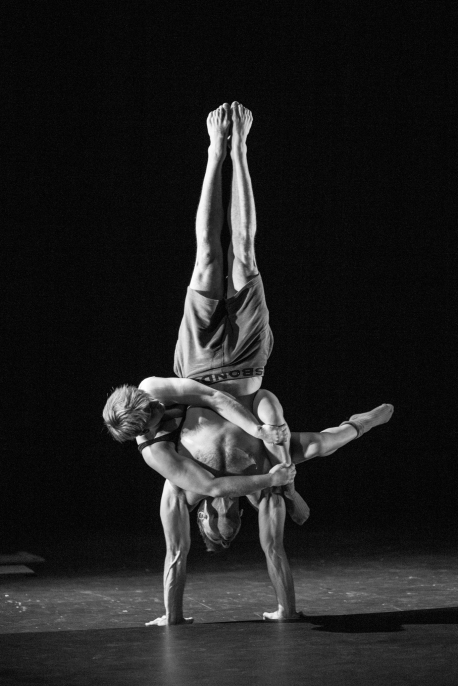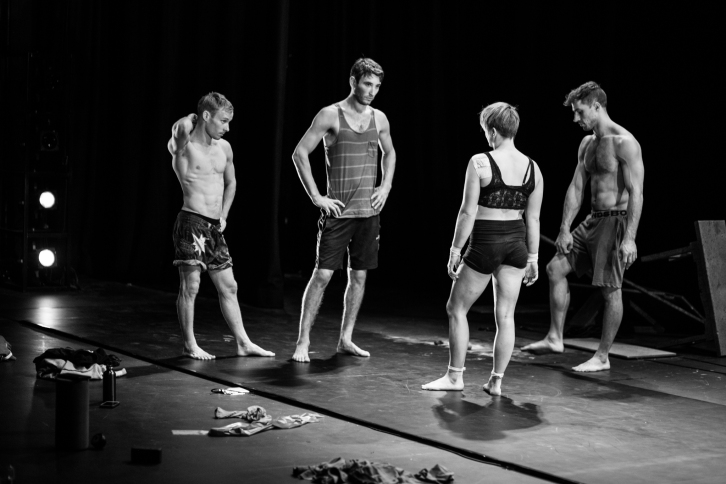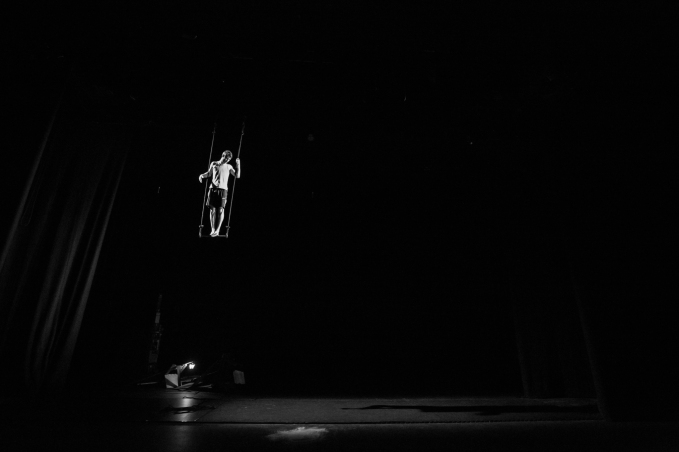Away from brash entertainment. Away from overt caricatures and cliches, away from hunting for laughs or applause. Toward… Art?
It seemed the next logical step.

I mean, It’s not as if I’ve mastered every area I’ve made a foray into, but I feel I performed a lot of them well enough to get a feel for what they are. Some I loved, some I didn’t. But I seem to be increasingly driven toward intellectualising shows, picking them apart and putting back together simply out of curiosity. I know I understand act construction in the traditional sense, for the traditional acts that could be loosely categorised as entertainment. But the mysteries and methods of the more artistic creations I loved to watch onstage were still purely philosophical in nature, and quite frightening.
Brief backstory: I’ve been in Brisbane with Casus these past 4 weeks, making a show called Finding The Silence. Simple premise for a show. It’s in the title. Thankfully there’s more to it than that, as I’d hoped there would be.
Here’s the promo the amazing Hamish McCormick put together from the season.
Talking to Idris Stanton (Circus Firemen, Pants Down Circus etc.) one night, he told me that when he fills out an immigration card he writes “Entertainer” in the occupation section. He does that on purpose, and for him that’s entirely accurate. He’s a brilliant entertainer. For me, I sit somewhere in between the two currently. I went through customs a few hours ago and I wrote “Artist”, but that’s this moment, on this tour, with this company.
Casus has shown me some creative mechanisms that until now have remained a mystery. I now attempt to summarise this new working method purely for my own sanity, and it seems to be something like this: Casus’s method is largely about accessing emotion through physicality, rather than physicality through emotion. In short, it’s the exact opposite of what I’ve learned to do. This fascinating process was made even more interesting for me due to having never done much physical improv before, and also having no prior instructions as to how to approach such things.
These two polar opposite approaches will take time to reconcile. They still occupy a somewhat uneasy relationship in my mind, and will probably continue to do so for some time. Here they are in more detail:
APPROACH 1.
The obvious approach to making theatrical work (for me anyway) was to identify the narrative in a scene, allocate some sort of rational progression of emotions to it, work on the physicality of those emotions and weave that into the story. Then, blend it all together and make it airtight. Circus in a traditional sense can make things difficult in that respect because of the necessity to perform physical feats, but it’s still a workable method. It’s the straightforward approach, especially when speaking of physical comedy routines or something with an obvious narrative. Character base, starting point, intended outcome, predicaments, overcome obstacles, resolution… or something like that. It was a good basis for me, grounded in logic and readable action-reaction stimuli which meant that if something didn’t make sense, it was easy to identify. A summary: justification of actions through narrative and character. Not always, but often, I employed this method of act construction. It’s rewarding and detailed, and allows for areas of spontaneity when the material is understood.
APPROACH 2
The other approach, the approach of companies like Casus, seems to be more grounded in finding physicality first. This is done through a variety of methods, with group and solo improvisation being vital to the feel and connection of performers’ bodies and minds. It’s a common approach in the dance and theatre world, I’m assuming. It feels like yoga, the way the the performance expands each time it is run. Details and nuances are discovered, energy ebbs and flows, internal narratives are written. This seems on the surface like a recipe for messy, uncontrolled creation and performance, but of course there are rules and boundaries put in place to give everyone a roughly similar trajectory. It’s not all improvisation. Especially in circus, you have to eventually do some tricks and they have to be planned.
Seeing these two different approaches begs the question, is the emotion the catalyst for physical expression, or is physical expression the catalyst for emotional portrayal? Are the two concepts so intertwined that any attempt to try break them apart simply becomes semantics? From what I understand, they are just separate tools that can be used where one sees fit. One is essentially method acting, and the other is… well, it’s something I’m now attempting to define. The role that acting plays in both is something that I’m also attempting to work through, and still needs to be addressed. How much acting can you inject into the second approach before it becomes overpowering? Isn’t the entire thing just acting anyway?
The emotional impact of each creative process on the performers themselves is quite different, too. I’m still getting my head around what the difference is and what it might mean.
Improvisation is something I’m now intensely curious about. I’m currently not physically educated enough to be as free as I want, and that frustrates me. There are moments of freedom, little flickers of that transcendent awareness I can imagine getting lost in, and that excites me. The connection with an organic, flowing performance is something beautiful. The parallel awareness of audience perspective and internal perspective also grows in this environment, if you foster it. By extracting individual moments and placing them in a choreographed piece or simply using the overall mood and body language of the improvisation, there is a rich sea of material which can be harvested in any way a director or choreographer sees fit.
It seems, actually, you can foster and stimulate anything you want in an improv session. It’s incredibly liberating. It becomes creativity purely for the sake of it, purely for the moment. There are much more eloquent and in-depth articles about improvisation on the web, I’m just trying to break apart my preliminary experiences of it in the past 4 weeks.
Here’s a wonderful article by Sebastian Kann about how and why circus performers are being drawn to the contemporary dance.

So as week one turned into week 2, the methods of creation for Finding The Silence became curiouser and curiouser. I was told by Jesse to be myself. Yeah, great advice, I thought. That little nugget almost sent me crazy. Up until this point, every one of my characters of performances has been myself, in one form or another, but with guidance from dramaturgical narrative at least. Now I felt I was left with no ground beneath my feet to stand on. What does that even mean, be yourself? The reason I had trouble getting my head around it was because the show we were creating seemingly had no narrative or characters! It wasn’t a matter of knowing myself, it was a matter of being myself. Wait, what?
Hmm. From the outset, it looked like an arcane concept I would struggle with, being myself onstage with no guidance.
But the more I looked, the more I picked at it, the more the hidden methodology came to light. You don’t have to plot the actions and reactions before you perform and then hope to embody them with feeling, you simply… you simply do them and are present while you do them. I realised that the polarity of these two creation and performance styles actually made the product of them similar in many ways. The outcome, although often stylistically different, still hoped to embody movement and emotion, narrative and performance, awareness of actions and reactions and an internal and external perspective on the performance.
The vagaries of the rehearsal room became more familiar and welcoming. I found connection in Emma’s beautiful vision of our handstand act and Lachie and Jesse’s love for each other. Everyone was under the pump; a roughly written but so-far unmade show, injuries within the company (hence my presence), Jesse fulfilling roles of both director and performer… and here’s me, badgering them all about the minutia of being yourself.
The differences, I see now, between the two styles of approaching the creation of work, are something like this:
With the first approach, you have a very direct idea and intention for the audience to receive. If that doesn’t happen, the success of the piece can be called into question. With the second approach, the intention of the piece is discovered by performer and audience alike, often in the same moment. Early on in the process, maybe in the first 50 shows or so, the intention of both styles are equally different: the first seeks to refine it’s intention, and the second seeks to discover and rediscover it’s meaning.
Something that has constantly driven me from job to job, style to style in terms of performance and circus, is curiosity. I don’t know how I’ve been lucky enough to actually get work in areas I’ve been curious about, but it’s happened consistently. This Side Up, street shows, corporate entertainment, cabaret shows, Circus Oz, fringe shows and now… the ‘artistic’ side of things. And there’s no condescension intended by the inverted commas, I assure you. For reasons that are currently unclear to me, I am emotionally effected by strange and wonderfully nebulous things onstage. And I very much want to learn how to have that effect on other people.
After the dress rehearsal 2 weeks ago, I was lost. Utterly lost. My preconceptions of everything went out the window in the first few days of rehearsal, and I was comfortable with that. But then on the night of the dress run, whatever ideas I had built up in my head of what the show was meant to be came crashing down. It was a dress run, and it was clunky, I know that. But where I would normally be able to confidently apply my knowledge of how to put a show together, suddenly I felt helpless. My tools and experience didn’t apply here. Oh dear, how unnerving.
As I made my coffee the following morning, I made a resolution: trust the show, because right now that’s my best chance at succeeding at anything. By the 5th and 6th nights, the audience were on their feet at the end. To trust a process while being relatively ignorant of it’s mechanisms was the dangerous commitment I had to make for my own sanity. And it worked.
What I do know is this: what I’m doing at this very moment is exactly what I want to be doing. That’s a nice one to go to bed at night with.

I just realised something: I wonder how many other completely unique and effective methods of creativity there are in the world? How many complete theatrical, movement, dance, and performance methodologies there must be floating around the world, changing people’s lives. What a thought! On that note, I think I’ve gotta do some more improvisation and more research…
Thanks for reading 🙂 I just arrived in Sweden, and it’s glorious. I’ve been slack on the blog front for a while, but I’m motivated again so prepare for me to hassle you to read more uneducated speculative ramblings. And, Please PLEASE, I love opinions so let me know what you think about anything from the content to the writing style. This is an open forum.
Vince.

Excellent musings Vince. You are tackling really big questions from the inside – exactly where they should be tackled from. I look forward to meeting you. J
LikeLike
John! Sorry for the belated reply, I thought I pressed send. One of those ones. Anyway, it’s wonderful you read this and I looked at your page too. I can’t wait for the whole thing, I feel I’m in somewhat of a pliable state at the moment and I want to take advantage of it…
Hope you’re well,
Vince.
LikeLike
I look forward to it very much!
LikeLike